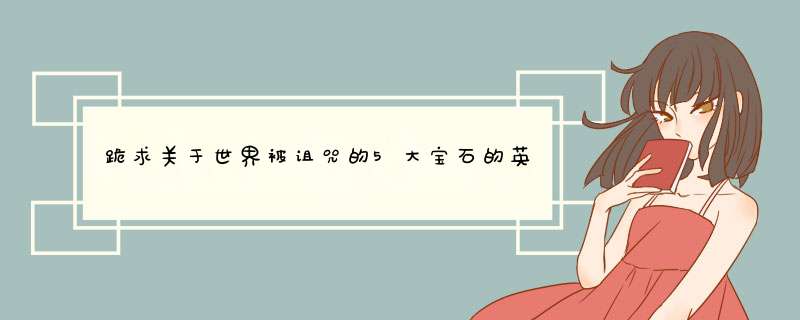
光明之山The Kōh-i Nūr
which means "Mountain of Light" in Persian,is a 105 carat (216 g) diamond (in its most recent cut) that was once the largest known diamond in the world It has belonged to various Hindu, Persian, Rajput, Mughal, Turkic, Afghan, Sikh and British rulers who fought bitterly over it at various points in history and seized it as a spoil of war time and time again It was most recently seized by the East India Company and became part of the British Crown Jewels when Queen Victoria was proclaimed Empress of India in 1877
he curse of the Koh-i-Noor
It is believed that the Koh-i-Noor carries with it a curse which affects men who wear it, but not women All the men who owned it have either lost their throne or had other misfortunes befall them Queen Victoria is the only reigning monarch to have worn the gem Since Victoria's reign, the stone has generally been worn by the British Queen Consort, never by a male ruler
The possibility of a curse pertaining to ownership of the diamond dates back to a Hindu text relating to the first authenticated appearance of the diamond in 1306: "He who owns this diamond will own the world, but will also know all its misfortunes Only God, or a woman, can wear it with impunity"
The Black Orlov Diamond创始者之眼
This dark steely grey stone is a cushion cut, 67 carat diamond
The history of the stone has been shrouded in mystery Legend is that once the black diamond was called The Eye of Brahma It was supposedly an uncut stone of 195 carats This stone was set into an idol in the vicinity of Pondicherry, India and stolen by a monk Some say that black is a bad luck color for Hindus and they would never have put a black stone on an idol Research shows that in the Hindu belief of the 3 eyes - one is the sun and one is the moon, on opposite sides of the head The sun represents the light and the moon, the dark So it may have been that a black diamond would have been used for the "moon eye"
Scarab 圣甲虫形珠宝饰物
Scarabs were popular amulets in ancient Egypt According to ancient Egyptian myths, the sun (Ra) rolls across the sky each day and transforms bodies and souls Modeled upon the Scarabaeidae family dung beetle, which rolls dung into a ball for the purposes of eating and laying eggs that are later transformed into larva, the scarab was seen as an earthly symbol of this heavenly cycle This came to be iconographic, and ideological symbols were incorporated into ancient Egyptian societyBeginning in the Old Kingdom of ancient Egypt, memorializing scarabs became common They were often incorporated into tombs, as grave goods, or given as 'gifts'
To the ancient Egyptians, the scarab or dung beetle was a protector of written products The scarab was also used as a holder or medium for personal name seals A figurine of a scarab would be carved out of stone, and then on the smooth stomach of the scarab, the engraving of a seal was made Later, this oval image was used for the representation of the cartouche, or name/title seals
Hope Diamond希望蓝钻石
The Hope Diamond, also known as "Le bleu de France" or "Le Bijou du Roi",[3] is a large, 4552-carat (910 g),[1][4][5] deep-blue diamond, now housed in the Smithsonian Natural History Museum in Washington, DC It is blue to the naked eye because of trace amounts of boron within its crystal structure, but exhibits red phosphorescence after exposure to ultraviolet lightIt has a long recorded history with few gaps in which it changed hands numerous times on its way from India to France to Britain and to the United States It has been described as the "most famous diamond in the world"and is said to be the second most-visited artwork in the world, after the Mona Lisa
The diamond has been surrounded by a mythology of a reputed curse to the effect that it brings misfortune and tragedy to persons who own it or wear it,
Jacques Colet bought the Hope Diamond from Simon Frankel and committed suicide
Prince Ivan Kanitovski bought it from Colet but was killed by Russian revolutionists
Kanitovski loaned it to Mlle Ladue who was "murdered by her sweetheart"
Simon Mencharides, who had once sold it to the Turkish sultan, was thrown from a precipice along with his wife and young child
Sultan Hamid gave it to Abu Sabir to "polish" but later Sabir was imprisoned and tortured
Stone guardian Kulub Bey was hanged by a mob in Turkey
A Turkish attendant named Hehver Agha was hanged for having it in his possession
Tavernier, who brought the stone from India to Paris was "torn to pieces by wild dogs in Constantinople"
King Louis gave it to Madama de Montespan whom later he abandoned
Nicholas Fouquet, an "Intendant of France", borrowed it temporarily to wear it but was "disgraced and died in prison"
A temporary wearer, Princess de Lamballe, was "torn to pieces by a French mob"
Jeweler William Fals who recut the stone "died a ruined man"
William Fals' son Hendrik stole the jewel from his father and later committed suicide"
Some years (after Hendrik) "it was sold to Francis Deaulieu, who died in misery and want"
Source: The New York Times, January 29, 1911
杀人魔镜Mirror Killer
The mirror was created by Simon Cromwell in 1743 After 2 days, he died of cerebral hemorrhage Up to now, it has killed 38 people that had looked into the mirror, whose deaths were all owing to cerebral hemorrhage
欢迎分享,转载请注明来源:浪漫分享网

 微信扫一扫
微信扫一扫
 支付宝扫一扫
支付宝扫一扫
评论列表(0条)